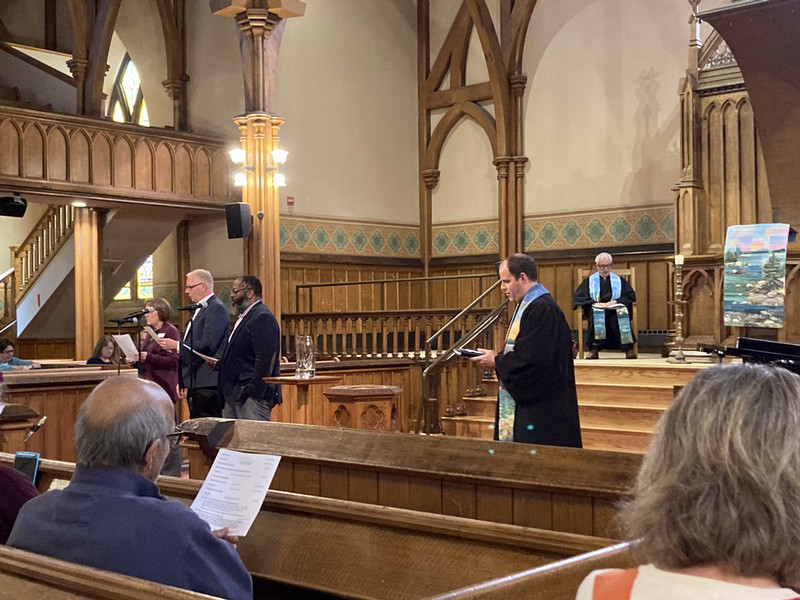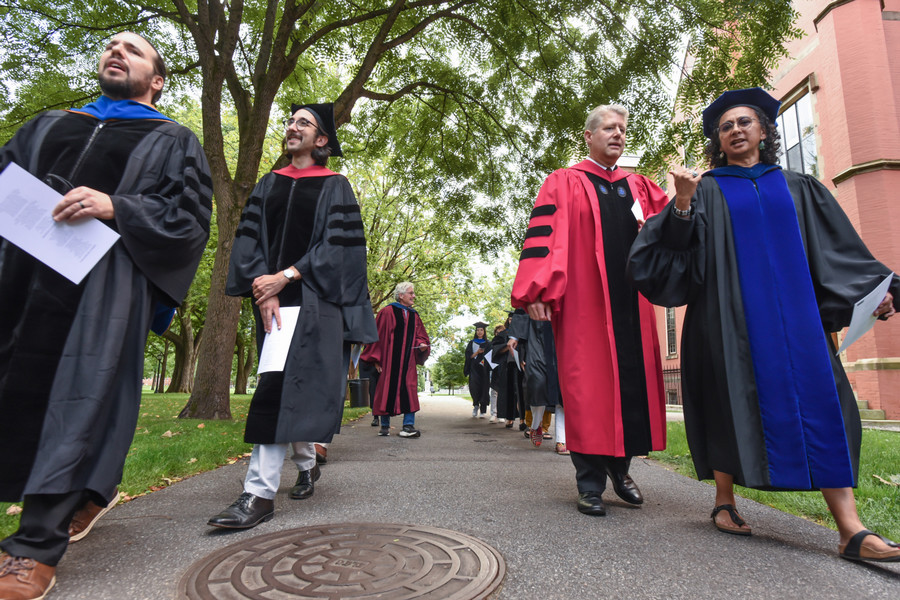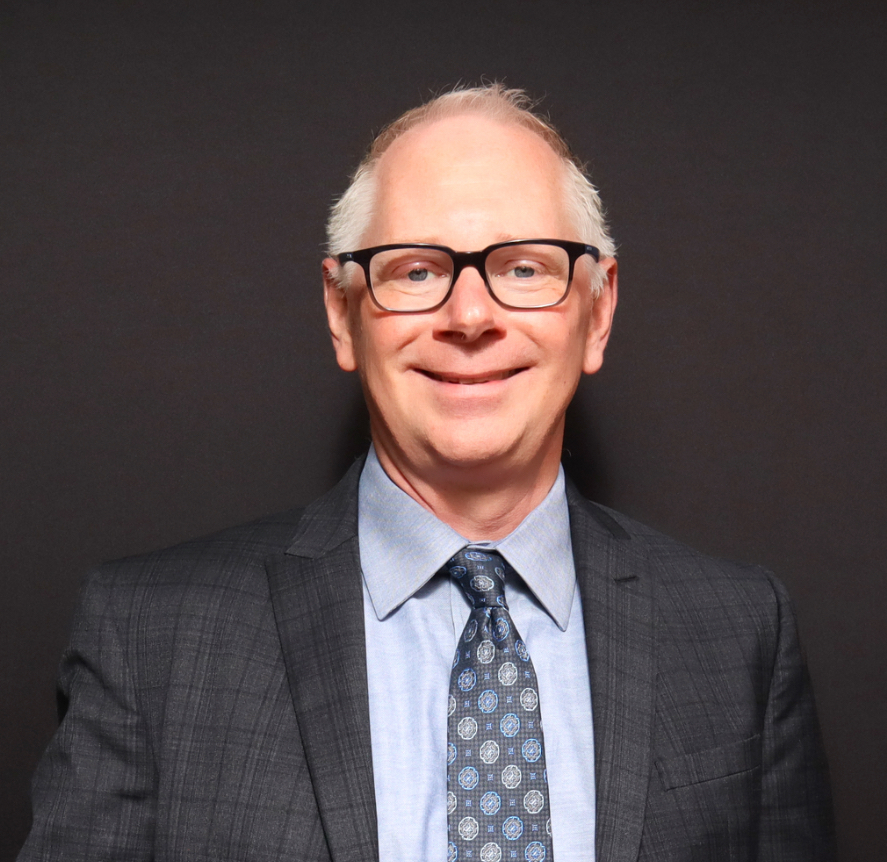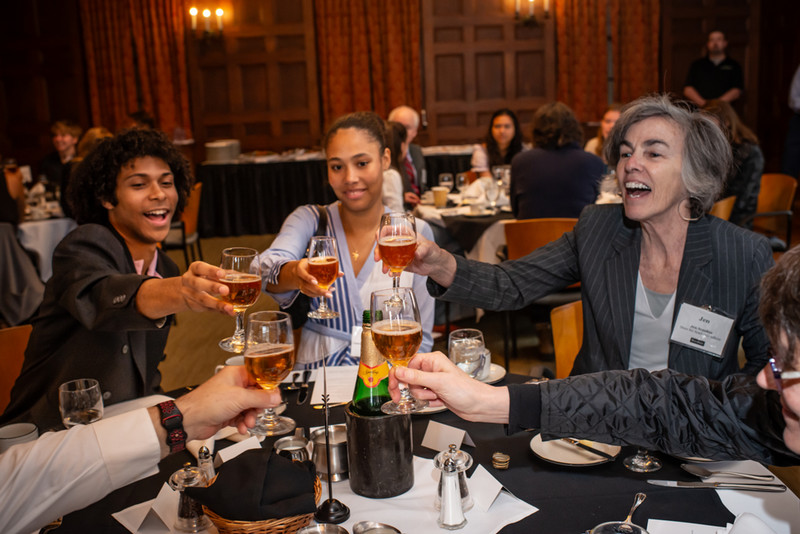'Voices From the Past': Convocation 2017 Remarks by Dean of Student Affairs Timothy Foster
By Tom PorterJust next door to where we are gathered today stands Massachusetts Hall—Bowdoin’s first building.
It opened 215 years ago in September 1802.
Back then, it was Bowdoin’s onlybuilding, and it not only served as classroom space. It’s also where the eight members of the Class of 1806 lived—for a time with President McKeen and his wife, Alice.
When President McKeen—a reverend—wanted the students to join him for prayer, all he had to do was tap his cane on the stairs.
It would never again be that simple to get students to comply with the president’s wishes!
We know why this first College building was named Massachusetts Hall. This wasMassachusetts in those days.
But what about the names of Bowdoin’s other buildings? What are some of those stories, and who are the people behind the names?
Searles is a good place to start, a building named for a woman who never set foot on the Bowdoin campus.
In 1892, William DeWitt Hyde—Bowdoin’s seventh president and author of “The Offer of the College”—wrote of the urgent—“even desperate”—need for a “scientific building,” warning that “within a year, Brunswick High School will have better accommodations for laboratory science...”
But, of course, there was no money in the budget, nor was there universal acceptance of the argument that a fancy new building was necessary.
As English Cardinal John Henry Newman had counseled, “Have a university in shanties,—nay, in tents, but have great teachers in it.” Sound advice, wrote Hyde, “…as long as it is necessary to choose between [teachers] and buildings.”
Hyde put out the appeal for donors, and Edward Searles, who had been an associate in a New York furniture and interior decorating firm, answered the call.
But did he really? And how does a decorator have that kind of money?
It’s a long and knotty story involving the California Gold Rush, railroad fortunes, San Francisco society, death, adoption, lawsuits, and ultimately the generosity and vision of Civil War General and New York attorney Thomas Hamlin Hubbard of the Class of 1857.
Louis C. Hatch provides a concise account of the tale in his 1927 “History of Bowdoin College.”
Mr. Searles had married a very wealthy woman who soon after died leaving him her property. Her relatives tried to break the will. Mr. Searles’s lawyer was General Hubbard, who saved the estate for his client. When Mr. Searles asked what was the lawyer’s compensation, General Hubbard replied, a science building for Bowdoin College.
Hatch continues…
According to another account, Mr. Searles paid his lawyer’s bill but expressed a wish to do something more and the General then mentioned the science building.
"But I have no connection with Bowdoin," said Mr. Searles. "What reason is there for my doing this?"
"Oh, give it in memory of your wife," said the General. And so, Bowdoin has the Mary Frances Searles Science Building.
Whatever is the exact truth of the matter, at least all [at Bowdoin] may join in the sentiment expressed by [Maine Supreme Court] Chief Justice [John] Peters, a graduate of Yale but a trustee and loyal friend of Bowdoin, [who said]
"Ain’t I glad that man married that woman."
And ain’t we allglad that man hired General Hubbard!
Thomas Hubbard had a guiding hand not only in Searles but also this building, Memorial Hall, and, of course, Hubbard Grandstand and Hubbard Hall, Bowdoin’s main library building from 1903 to 1965.
Designed by noted English architect Henry Vaughn, who also designed Searles, Hubbard Hall ended up costing twice as much as originally planned.
But the General would spare no expense. After all, he was—as he said—giving the building not to the College, but to the library.
Back then, it had a space on the second floor for the president (it was under a stairway) and—just down the hall—a paneled two-room apartment for General Hubbard to use when he was in Maine.
He may have been well-off, but the General apparently also knew that it can be wicked tough to find summer housing in these parts!
I’ll close my remarks with the story of another College building, this one located just behind Hubbard Hall across College Street: The John Brown Russwurm African American Center.
Today, we might easily know this nineteenth century building—originally two residences under one roof—as Packard House, or Smyth House, or Johnson House, or Little-Mitchell House; all the names of Bowdoin faculty who lived there over the years.
In 1970, the Little-Mitchell house was dedicated as the Afro-American Center by President Roger Howell. Why there? Well, it likely had something to do with the fact that previous residents Professors Alpheus Spring Packard of the Class of 1816 and William Smyth of the Class of 1822 were both passionate abolitionists who harbored escaping slaves on College Street.
One of their students was John Brown Russwurm of the Class of 1826, the third African American student to graduate from an American college or university, and the first at Bowdoin.
Russwurm would go on to co-edit Freedom’s Journal, the first African American owned and operated newspaper published in the United States.
In the paper’s first issue, Russwurm and his co-editor wrote:
Too long have others spoken for us, too long has the public been deceived by misrepresentations….
We deem it expedient to establish a paper and bring into operation all the means with which our benevolent creator has endowed us, for the moral, religious, civil and literary improvement of our race….
Russwurm would later serve as governor of the Maryland Colony in Liberia, and in 1979, the former Little-Mitchell House was rededicated in his honor by President Howell, whose words from that day guide us still:
As we have become, in terms of admissions, a more national college, so too has grown the awareness that we are under an obligation to strive for a student body reflective of the marvelous diversity of American society, and that sense of obligation must not fade…
it is all too easy to stray off the path, to become entangled in the briars and thorns that line its route, to sit down discouraged because the walking is difficult and the climbing harder still…
Our vision, as John Brown Russwurm’s was, must be to the future.
We will walk on—and we will walk on together—and Bowdoin will be the better college for it.”
There are 116 buildings at Bowdoin today, each with its own unique history and many named for people we ought to know.
As you live in, work, study, compete in and pass these buildings, take a moment to learn something about these people and their lives.
As you do, you will learn more about Bowdoin history and traditions, about the people who built our College, who inspire us, and who helped to make this campus of ours one of the most historic and most beautiful in America.
Thank you for listening.



